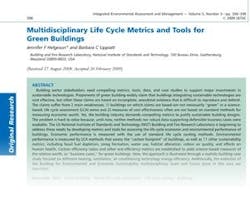Investments Justified in Sustainable Building Projects
In a recent issue of Integrated Environmental Assessment and Management, researchers from the National Institute of Standards and Technology discussed metrics they developed to help the building industry make better decisions when it comes to funding green projects.
Although sustainable technology proponents agree that there are long-term financial benefits to investing in green buildings, until now, there have been no standardized data or methods available to make a sound business case. The researchers developed life-cycle, science-based metrics that address the environmental and economic concerns of investors, society, and other stakeholders.
In this case study, the authors present short- and long-term costs associated with a hypothetical structure created according to typical tall building specifications. Understanding the economic costs associated with buildings is easier than understanding environmental costs; therefore, they broadened the scope of current evaluation methods, such as life-cycle assessments. The idea is to apply the new metrics developed to all types of building design proposals so that informed decisions can be made.
This research is important because it helps resolve the conflict between sustainability and economic development that often arises. Sustainability is about meeting present and future needs in terms of economics, the environment, and society as a whole. As concerns about climate change and access to natural resources continue to rise, it's especially important to find ways to maintain economic stability and reduce the effects of carbon emissions and the amount of energy used.
Conventional building methods involve lower construction costs and promise greater returns to investors in the short run; however, when true life-cycle costs are taken into account, the long-term economic - and environmental - return on investment for funding sustainable buildings is considerably higher. The advantages of sustainable building go beyond reduced energy costs and include other benefits, such as water efficiency, increased property values, and improved employee productivity.
As the building industry adopts this new integrated approach in the decision-making process, it will be able to make more accurate and credible business cases for growing the sustainable building market.
To read the entire study, Multidisciplinary Life Cycle Metrics and Tools for Green Buildings [2009, Vol. 5(3):390–398], visit www.allenpress.com.
